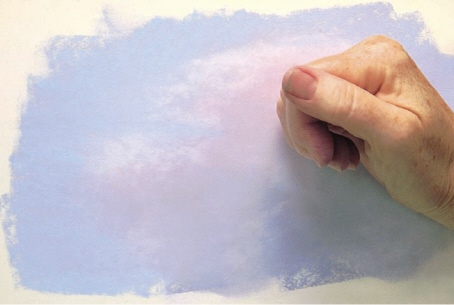
blending colors
You can use your fingers to blend pastels to create dramatic skies and mirrored reflections. Over-blending flattens colors and can make them muddy, but used properly, this technique is great for skies and water.
To understand the pros and cons of blending, you must first understand the characteristics of the pastel pigment. The structure of the particles of pigment is crystalline, with facets like a cut diamond. This is what makes pastel paintings so luminous and brilliant. But when you blend the pastel, you are to some extent flattening or crushing those faceted particles. If you want to dull a color to help push it toward the background of a painting, such as in the sky, this can be an advantage. But if you want to keep the characteristic luminosity and glow of pastel, apply an unblended layer of color.

BEFORE
first layer of color
To paint soft, fluffy clouds, first apply pastel to a sanded paper, or other surface with a fair amount of ˝tooth,˝ using a number of colors. Clouds aren’t just white! Look for pale pinks, lavenders, yellows, greens, blues and grays, and put all the colors you see on the paper. Put enough pastel on the surface to blend, but not so much that the grain is filled.

AFTER
colors blended together
Using the side of your hand, you can blend the colors together with a circular motion, bringing them right over the edge of the blue sky. More pastel can be added after the first blending.
protecting your hands
You can wear a latex glove if you wish, or use a barrier cream to protect your skin. If you’re working on a sanded surface, avoid excessive blending without a glove: You could sand your skin to the point of bleeding into the pastel!